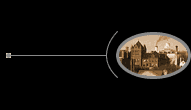


 |
  |
|
| Ordinance of 1787. |
The story of the University of Wisconsin begins with the famous Ordinance of 1787, enacted for the government of the Territory of the United States Northwest of the River Ohio.1 It will be remembered that within this region, familiarly styled by historians the Old Northwest Territory, were afterwards formed the States of Ohio, Indiana, Illinois, Michigan, and Wisconsin. The Ordinance not only established a liberal and enlightened form of government in the Territory and in the States to be carved from it, and secured freedom of commerce upon its waterways and portages, but contained two remarkable clauses which were destined to exert a powerful influence on the history of the Old Northwest--the one, providing that there should never be any form of slavery within the Territory, save as punishment for crime; the other, this mandatory provision for popular education: "Religion, morality, and knowledge being necessary to good government and the happiness of mankind, schools and the means of education shall forever be encouraged." No doubt the policy of establishing and endowing Territorial and State colleges in the Northwest, as a "means of education," was clearly in the minds of the congressmen who passed the Ordinance. Harvard and other colleges had received numerous and liberal grants in colonial days; this method of assistance to higher education was familiar to the statesmen of the period. When Ohio was admitted to statehood (February 19, 1803), she received as an endowment for a university, two townships (46,080 acres) of that portion of the national domain lying within her borders; so did Indiana, Illinois, and Michigan, in turn, when they became Territories. |
|
| Academy grant sought. |
Wisconsin Territory was erected by act of Congress approved April 20, 1836; but it was the fourth of July before the Territorial officers were sworn in, and the twenty-fifth of October before the meeting of the Territorial legislature (at Belmont, in what is now La Fayette county). On the twenty-sixth, Governor Dodge presented his first message, therein recommending that Congress be memorialized for the grant of one township of land for the support of an academy. The recommendation was not followed, although at this session an act was passed for the establishment of the "Wisconsin University" at Belmont; but, beyond the naming of thirty-one trustees, nothing was done toward carrying the project into effect. |
 HENRY DODGE |
| Territorial University established. |
The next session of the Territorial legislature was held at Burlington (in what is now Iowa),2 from November 6, 1837, to January 20, 1838. At the first session, Madison had been chosen as the seat of Territorial government, but the legislative sessions were to be held at Burlington until the capitol was erected. November 24 (1837), Mr. Arndt, of Green Bay, introduced in the Council a bill to establish the "Wisconsin University of Green Bay," which was passed on the first of December; later (under Protestant Episcopal auspices), this institution became entitled Hobart University. December 27, Mr. Sheldon, of Milwaukee, introduced in the House "a bill to establish a University at the City of the Four Lakes," in the vicinity of Madison.3 This passed the House on January 5, but in the Council was verbally amended, so as to provide "That there shall be established at or near Madison, the seat of government, a University for the purpose of educating youth, the name whereof shall be 'the University of the Territory of Wisconsin.'" On the seventeenth, the House concurred in this amendment; on the nineteenth, the governor approved the act.4 The University thus projected was placed "under the government of a board of visitors not exceeding twenty-one in number, of whom the Governor and the Secretary of the Territory, the Judges of the Supreme Court, and the President of the University shall be part"--the others being named in the act, most of them citizens of considerable distinction.5 |
|
| First land-grant secured. |
By joint resolution, the legislature directed the Territorial delegate in Congress to ask from that body an appropriation of $20,000 for University buildings, in addition to the grant of two townships of land which it had now become the custom to bestow upon each new Territory as a University endowment. The appropriation was not secured, but the land-grant was duly made, by act of Congress approved June 12, 1838; by its terms, this land was to be "for the use and support of a University within the said Territory, and for no other use or purpose whatsoever." Clearly, it was the intent of Congress that the fund created by this gift should be used only for the maintenance of the University, the presumption being that the young commonwealth would itself provide the buildings and grounds. Another clause in this act was of far-reaching importance: it was provided that, in selecting the land, the Territory might choose sections (seventy-two in number) "out of any of the public lands within the territory * * * to which the Indian title has been, or maybe, extinguished." Earlier grants--except to Michigan--had provided that the townships should be selected en bloc. The privilege of selecting at random, in seventy-two different lots, proved, as we shall see in succeeding chapters, disastrous to the University fund. The act establishing the University had stipulated that the board of visitors should hold their preliminary meeting on the first Monday in July, 1838; but evidently there was no quorum at that time, for we find no record of a meeting previous to the first of December.6 At this initial and only session of the board, the legislature was requested at once to appropriate the land-grant for the benefit of the University, and a committee was appointed to select a site for the institution. In January following, the legislature, by joint resolution, appointed commissioners7 to locate a portion of the lands, not exceeding two-thirds of the grant, in such manner "as will best promote the interests of the University." The commissioners were to meet in Madison on the first Monday in May; but, on the plea of not having received official notice of their appointment, they took no action. |
|
| First location of lands. |
In his message to the legislature, in December, 1839, Governor Dodge called attention to the failure thus far to locate University lands, and urged early action. January 11 (1840), a joint resolution was adopted, authorizing the governor to appoint a person in each of the land districts--Green Bay, Milwaukee, and Mineral Point (or Wisconsin)--to locate a portion, not to exceed two-thirds, of the congressional grant to the University. During that year, 20,497 acres were thus located in the Green Bay and Milwaukee districts; but the selection of 10,248 acres in the Mineral Point district, not having been approved by the secretary of the treasury, was rejected. Early in 1841 (January 29), the legislature empowered the governor to appoint a new locating commissioner in the Mineral Point district; Nathaniel P. Myer was accordingly chosen, and appears to have performed his task to the satisfaction of all concerned. Of the congressional grant of seventy-two sections, there now remained a fraction over 25,582 acres, and these were all located during Territorial days. |
|
| Ahead of the times. |
But, although selected, the University lands remained unused until Wisconsin had entered the Union. While there appear to have been a few citizens of the Territory much interested in advancing the cause of higher education, to the great majority of the hard-fisted frontiersmen of Wisconsin, who were energetically engaged in wresting a somewhat meagre livelihood from the soil and forests, the proposed University seemed an enterprise far removed from the actual necessities of Western life.8 This generally-prevalent conviction, that such an institution was as yet uncalled for, and that taxes for the erection of college buildings would prove unpopular among a people hard pressed for money, prevented its handful of supporters from pushing the project with vigor. The Territorial board of visitors, appointed in 1838, continued to hold office for ten years, but held no meetings and transacted no business, possibly most of the members soon forgot the fact of their appointment. The board served nevertheless to keep the organization and its basic idea alive, if sleeping, and was the seed from which, in due time, sprang the board of regents of Statehood days. |
 LAKE MENDOTA, FROM UNIVERSITY BAY |
1 Adopted by the Congress of the Confederation, at Philadelphia, July 13, 1787; confirmed by the Congress of the United States, August 7, 1789.
2 Iowa was then a part of Wisconsin Territory; so also what is now Minnesota, and a large part of the Dakotas.
3 The City of the Four Lakes was a town on paper, platted on the north shore of Lake Mendota, at what are now called Livesey's Springs. Several Territorial officials were interested in the project, but it came to naught.
4 Laws of Wis. Terr., 1838, chap. 99.
5 They were Bushnell B. Cary, Marshall M. Strong, Byron Kilbourn, William A. Gardner, Henry Stringham, Charles R. Brush, Charles C. P. Arndt, John Catlin, George H. Slaughter, David Brigham, John F. Schermerhorn, William W. Coriell, George Beatty, Henry L. Dodge, and Augustus A. Bird.
6 Wisconsin Enquirer (Madison), December 8, 1838.
7 John V. Suydam, of Brown county; Francis O. Kirkpatrick, of Iowa county; and Jeremiah B. Zander, of Milwaukee county.
8 In his address to the legislature, delivered December 10, 1841, Governor Doty said: "The means having been provided for the support of a University, I would respectfully urge the necessity of its location, and that provision be made for the commencement of some one or more of its branches. It is our duty to secure the means of education to every class of society but common schools are justly entitled to our first care, being the foundation of all others, and an essential institution for the preservation of American liberty."--House. Journ., 1841-42, p. 24.
See also, Chancellor Lathrop's lucid statement of the situation, in 4th Ann. Report, Board of Regents, 1851, pp. 8, 9.